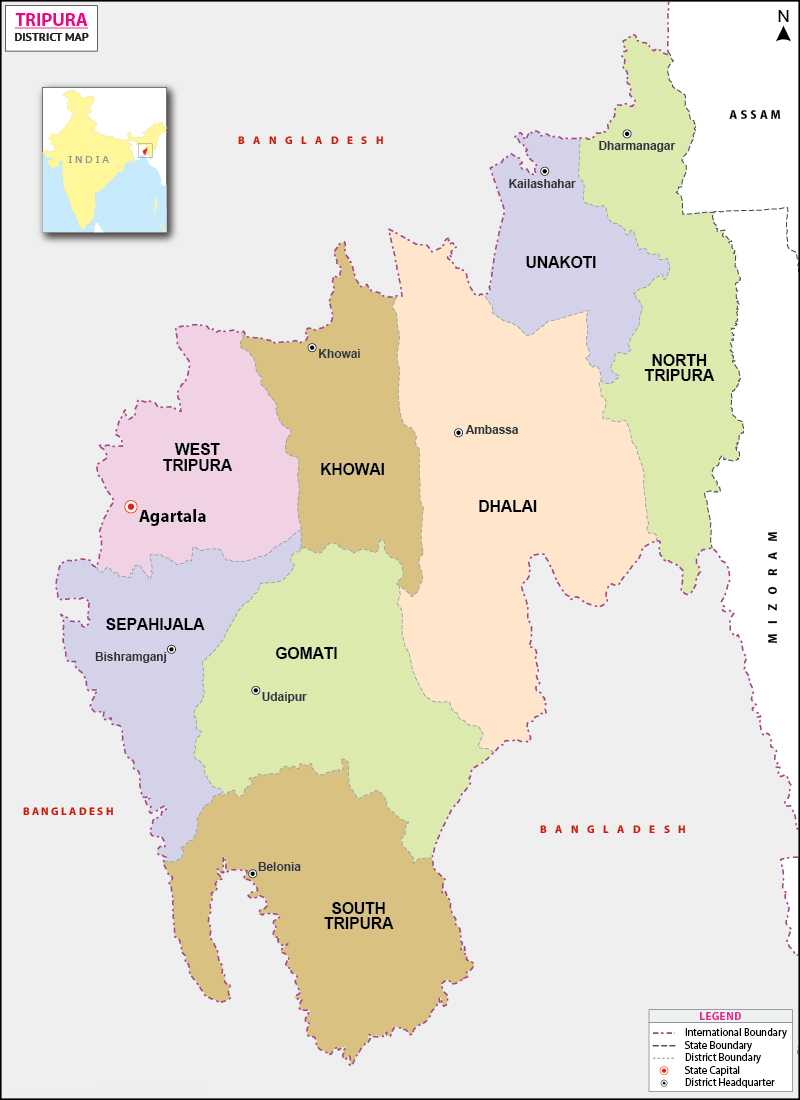Internal Security
Greater Tipraland: Tripura
- 04 Dec 2021
- 5 min read
Why in News
Recently, several tribal outfits in Tripura have joined hands to push their demand for a separate state, Greater Tipraland for indigenous communities in the region.
- Among the political parties that have come together for the cause are TIPRA Motha (Tipraha Indigenous Progressive Regional Alliance) and IPFT (Indigenous People’s Front of Tripura).
Key Points
- The Demand:
- The parties are demanding a separate state of ‘Greater Tipraland’ for the indigenous communities of the north-eastern state.
- They want the Centre to carve out the separate state under Article 2 and 3 of the Constitution.
- Among the 19 notified Scheduled Tribes in Tripura, Tripuris (aka Tipra and Tiprasas) are the largest.
- According to the 2011 census, there are at least 5.92 lakh Tripuris in the state, followed by Bru or Reang (1.88 lakh) and Jamatias (83,000).
Article 2 & 3
- Article 2: Parliament may by law admit into the Union, or establish, new States on such terms and conditions as it thinks fit.
- However, Parliament cannot establish a new union territory by passing a law, that can only be done through a constitutional amendment.
- States like Sikkim (previously not within India) became a part of the country under Article 2.
- Article 3: It empowered the Parliament to make law relating to the formation of new states and alteration of existing states.
- Immediate Cause:
- The churn in the state’s politics with the rise of TIPRA Motha and the Assembly polls due in early 2023 are the two major reasons behind the development.
- Historical Background:
- Tripura was a kingdom ruled by the Manikya dynasty from the late 13th century until the signing of the Instrument of Accession with the Indian government in 1949.
- The demand stems from the anxiety of the indigenous communities in connection with the change in the demographics of the state, which has reduced them to a minority.
- It happened due to the displacement of Bengalis from the erstwhile East Pakistan between 1947 and 1971.
- From 63.77% in 1881, the population of the tribals in Tripura was down to 31.80% by 2011.
- In the intervening decades, ethnic conflict and insurgency gripped the state, which shares a nearly 860-km long boundary with Bangladesh.
- The joint forum has also pointed out that the indigenous people have not only been reduced to a minority, but have also been dislodged from land reserved for them by the penultimate king of the Manikya dynasty Bir Bikram Kishore Debbarman.
- Initiatives to Address the Issue:
- Tripura Tribal Areas Autonomous District Council:
- The Tripura Tribal Areas Autonomous District Council (TTADC) was formed under the sixth schedule of the Constitution in 1985 to ensure development and secure the rights and cultural heritage of the tribal communities.
- ‘Greater Tipraland’ envisages a situation in which the entire TTADC area will be a separate state. It also proposes dedicated bodies to secure the rights of the Tripuris and other aboriginal communities living outside Tripura.
- The TTADC, which has legislative and executive powers, covers nearly two-third of the state’s geographical area.
- The council comprises 30 members of which 28 are elected while two are nominated by the Governor.
- The Tripura Tribal Areas Autonomous District Council (TTADC) was formed under the sixth schedule of the Constitution in 1985 to ensure development and secure the rights and cultural heritage of the tribal communities.
- Reservation:
- Also, out of the 60 Assembly seats in the state, 20 are reserved for Scheduled Tribes.
- Tripura Tribal Areas Autonomous District Council:
Other Demands in the North East
- Greater nagalim (Parts of Arunachal Pradesh, Manipur, Assam and Myanmar)
- Bodoland (Assam)
- Tribal Autonomy Meghalaya
Way Forward
- Economic and social viability rather than political considerations must be given primacy.
- There should be certain clear-cut parameters and safeguards to check the unfettered demands.
- It is better to allow democratic concerns like development, decentralisation and governance rather than religion, caste, language or dialect to be the valid bases for conceding the demands for a new state.
- Apart from this the fundamental problems of development and governance deficit such as concentration of power, corruption, administrative inefficiency etc must be addressed.





